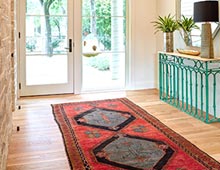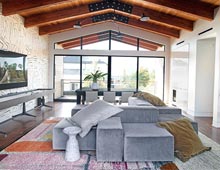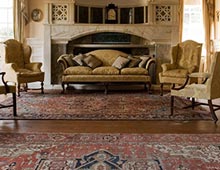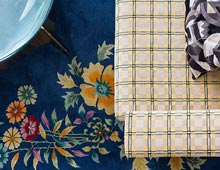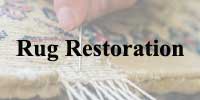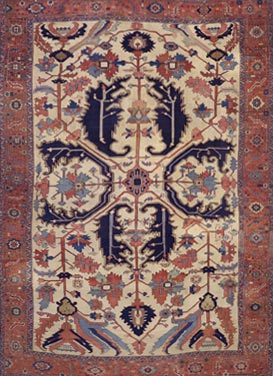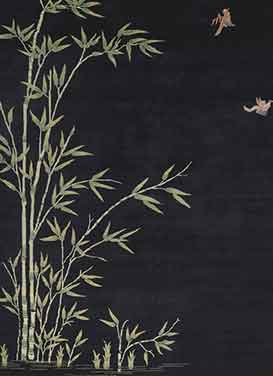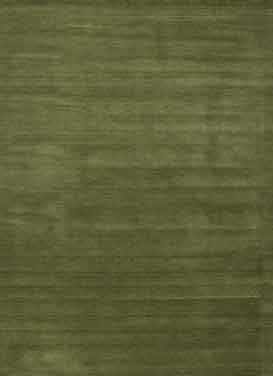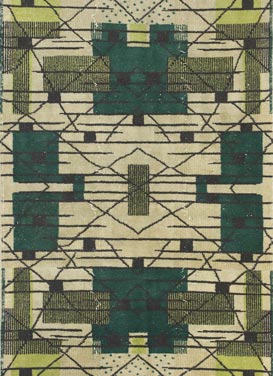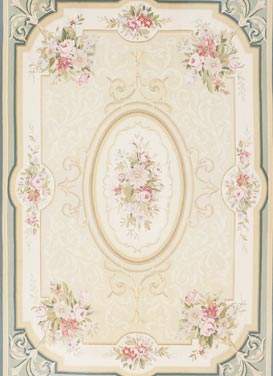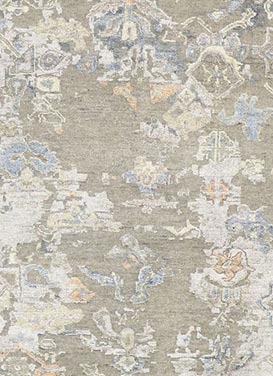Guide to Rugs and Carpets
A Guide to Oriental Rug Terms
Welcome to the comprehensive Esmaili Rugs Guide to Rugs and Carpets, designed to assist homeowners, aspiring designers, and anyone intrigued by the fascinating world of Oriental rugs and antique carpets. Delve into a realm where intricate terminology weaves together the rich tapestry of these exquisite floor coverings. Whether you're a seasoned interior designer, a homeowner seeking to enhance your living spaces, a trade professional, or a passionate rug enthusiast, navigating this intricate lexicon is crucial. Our expertly curated glossary of Oriental rug and carpet terms, painstakingly crafted by Esmaili Rugs and Antiques, Inc., will unravel the mysteries of these artful creations. We are dedicated to clarity, using plain and accessible English to demystify these terms. If ever you encounter an unfamiliar phrase or concept, please don't hesitate to reach out – we're here to guide you on this captivating journey.
A
Antique Rug
An "antique rug" refers to a rug that is typically over 100 years old and is considered a valuable collector's item due to its historical significance, craftsmanship, and unique design. Antique rugs often exhibit distinctive weaving techniques, patterns, and color palettes that reflect the cultural and artistic influences of their time.
Abrash
"Abrash" is a term used to describe subtle variations in color or tone within a rug's field or pattern. These variations occur due to differences in the dye lots of the wool or other factors during the weaving process. Abrash is considered a desirable characteristic, adding depth and character to a rug's design.
Afghan War Rugs
Afghan War Rugs are a unique category of rugs woven during the Russian occupation of Afghanistan in the mid-1980s. These rugs feature motifs related to weaponry, including tanks, fighter planes, helicopters, grenades, and guns. Afghan War Rugs offer a glimpse into the socio-political context of the time and have gained recognition as collectibles.
Allover Design
An allover design in rug patterns refers to a repetitive motif that covers the entire field without a central medallion or distinct borders.
Anatolian Rugs
Anatolian rugs are handwoven carpets originating from Anatolia, a region in modern-day Turkey. These rugs are known for their diverse range of designs, including geometric patterns, floral motifs, and medallion styles. Anatolian rugs have a rich history dating back centuries and remain popular among collectors and rug enthusiasts.
Animal Motifs
Animal motifs in rugs are decorative elements that depict various animals, birds, or mythical creatures. These motifs can hold cultural, symbolic, or aesthetic significance and are often used to convey specific meanings or stories within rug designs. Examples include depictions of lions, birds, dragons, or phoenixes.
Antique Rugs
Antique rugs are rugs that are typically over 100 years old. They often hold historical, cultural, and artistic significance, making them valuable collector's items.
Armenian Rugs
Armenian rugs have a rich history dating back centuries. They are known for their intricate designs, vibrant colors, and cultural symbolism.
Art Deco Rugs
Art Deco rugs are influenced by the Art Deco design movement, which emerged in the early 20th century. These rugs feature bold geometric patterns, sleek lines, and vibrant colors. Art Deco rugs are prized for their modernist aesthetics and are often used to enhance contemporary interior spaces.
Art Silk (Artificial Silk)
Art silk, short for "artificial silk," is a synthetic fiber that mimics the appearance of natural silk. It is sometimes used in rug production as a more cost-effective alternative to genuine silk.
Aubusson Rugs
Aubusson rugs originate from the town of Aubusson in France, known for its traditional tapestry and rug production. These flat-woven rugs often feature intricate floral designs, pastoral scenes, and classical motifs. Aubusson rugs have a timeless elegance and are considered works of art.
Axminster Rugs
Axminster rugs are machine-made rugs produced using a weaving technique that combines cut pile and loop pile, resulting in a textured surface with intricate patterns. These rugs are known for their durability and are commonly used in hospitality and residential settings.
Azeri Rugs
Azeri rugs are handwoven by Azerbaijani artisans and are recognized for their distinct geometric patterns and bold, vibrant colors.
B
Baluch Rugs
Baluch rugs are hand woven rugs produced by the Baluch people, a nomadic tribe primarily living in Iran, Afghanistan, and Pakistan. These rugs are characterized by their tribal designs, intricate motifs, and earthy color palettes. Baluch rugs often feature geometric patterns and rich symbolism.
Bessarabian Rugs
Bessarabian rugs are woven in the historical region of Bessarabia, which spans parts of modern-day Moldova, Ukraine, and Romania. These rugs are known for their distinctive floral designs and often feature bouquets of flowers or intricate garden scenes. Bessarabian rugs are highly regarded for their decorative appeal.
Bokhara Rugs
Bokhara rugs are produced by the Tekke tribe in Central Asia. They are characterized by their geometric patterns, often featuring a distinctive gul motif.
Border
The "border" of a rug is the outermost edge that frames the central field. Borders can vary in width and design, and they play a crucial role in defining the overall look of a rug. Borders often feature intricate patterns, guard stripes, and decorative elements that complement the field's design.
Botanical Motifs
Botanical motifs in rugs include depictions of various plants, flowers, and trees. These motifs are used to create vibrant and naturalistic designs within rug patterns, adding a touch of nature's beauty to interior spaces.
Boteh (Paisley)
The boteh, or paisley, is a droplet-shaped design element used in rug patterns. It has a rich history and is associated with various cultures.
C
Caucasian Rugs
Caucasian rugs originate from the Caucasus region, which spans parts of modern-day Armenia, Azerbaijan, Georgia, and Russia. These rugs are known for their bold geometric designs, tribal motifs, and vibrant color combinations. Caucasian rugs are prized for their authenticity and cultural significance.
Chinese Rugs
Chinese rugs boast a long history and are known for their intricate designs, often featuring symbols of longevity, happiness, and prosperity.
Chobi Rugs
Chobi rugs, also known as "Ziegler Chobi" or "Peshawar Chobi," are hand-knotted rugs woven in Afghanistan and Pakistan. They are characterized by their muted earth-tone colors, soft wool, and traditional designs. Chobi rugs often feature floral patterns and are popular choices for both traditional and contemporary interiors.
Collector's Rug
A "collector's rug" is a rug that holds exceptional value and significance among rug enthusiasts and collectors. These rugs are typically rare, antique, or of exceptional craftsmanship, design, and historical importance. Collector's rugs are sought after for their investment potential and artistic merit.
Contemporary Rug
A "contemporary rug" refers to a rug that is designed and woven in a modern style, often influenced by contemporary art, design, and fashion trends. These rugs may feature abstract patterns, innovative materials, and unconventional color schemes, making them suitable for contemporary interior spaces.
Cotton Foundation
A "cotton foundation" in a rug refers to the use of cotton threads as the warp and weft in the rug's construction. Cotton foundations are known for their durability and ability to hold intricate rug designs. Cotton is a commonly used material in many handwoven rugs.
D
Dhurrie Rugs
Dhurrie rugs, also spelled "dhurri" or "dari," are flat-woven rugs originating from India. These rugs are typically made from cotton or wool and feature geometric patterns and bold colors. Dhurrie rugs are lightweight and versatile, suitable for both traditional and modern interiors.
Distressed Rug
A "distressed rug" is intentionally aged or treated to create a vintage or weathered appearance. These rugs often undergo processes such as tea-washing or stone-washing to achieve a faded or worn look. Distressed rugs are valued for their unique character and timeless charm.
Dye Lots
Dye lots refer to batches of dyes used in rug production. Variations in dye lots can result in abrash, adding character to the rug.
E
Eclectic Rug
An "eclectic rug" is a rug that combines diverse design elements, patterns, or cultural influences, creating a harmonious blend of styles. These rugs are characterized by their versatility and ability to complement various interior design aesthetics.
Embroidered Rug
An "embroidered rug" is a rug that features decorative embroidery or stitching on its surface. Embroidery can be used to enhance rug designs, add texture, or create intricate patterns. These rugs often require meticulous handiwork and craftsmanship.
Ersari Rugs
Ersari rugs are crafted by the Ersari Turkmen tribe. They are recognized for their deep reds, blues, and geometric designs, often featuring gul motifs.
F
Flokati Rug
A "Flokati rug" is a traditional Greek rug known for its long, fluffy pile made from wool. These rugs are soft to the touch and add warmth and texture to interior spaces. Flokati rugs are prized for their cozy and inviting appearance.
Fringe
The "fringe" of a rug refers to the loose or knotted threads that extend from the ends of the rug. Fringes are often considered a decorative element and can vary in length and style. They are an integral part of a rug's construction and design.
G
Gabbeh Rugs
Gabbeh rugs are handwoven rugs originating from Iran, particularly the Qashqai tribe. These rugs are known for their simplicity, thick pile, and bold geometric designs. Gabbeh rugs often feature abstract motifs and vibrant colors, making them highly expressive and artistic.
Garden Motifs
Garden motifs in rugs depict scenes of lush gardens, floral arrangements, and natural landscapes. These motifs are used to create visually captivating and harmonious rug designs, evoking a sense of tranquility and natural beauty.
Garden of Paradise
The Garden of Paradise is a design motif found in some Oriental rugs. It symbolizes an idyllic, heavenly place often depicted with lush gardens and flowing rivers.
H
Hand-Knotted Rug
A "hand-knotted rug," also known as a "handmade rug," is a rug crafted entirely by hand, with each individual knot tied by skilled artisans. Hand-knotted rugs are highly regarded for their quality, durability, and intricate designs. They are often considered works of art due to the labor-intensive process of their creation.
Heriz Rugs
Heriz rugs are handwoven rugs originating from the Heriz region in northwest Iran. These rugs are known for their bold geometric patterns, large medallions, and rich earth-tone colors. Heriz rugs are renowned for their durability and are often used in high-traffic areas.
I
Indigo Dye
Indigo dye is a natural dye derived from the leaves of the indigo plant. It has been used for centuries to color textiles, including rugs. Indigo dye is known for its deep blue hue and its role in creating vibrant and long-lasting colors in rug weaving.
Islamic Carpets
Islamic carpets encompass a wide range of rugs produced in regions with Islamic influence. They often feature intricate geometric and floral patterns.
J
Jute Rug
A "jute rug" is a rug made from natural jute fibers, which are derived from the jute plant. Jute rugs are known for their eco-friendly properties, natural texture, and earthy appearance. They are often used to add a rustic or coastal vibe to interior spaces.
Jajim
Jajim is a flat-woven textile that originates from Persia and is often used as a decorative piece or for utilitarian purposes.
K
Kazak Rugs
Kazak rugs originate from the Caucasus region and are known for their bold and tribal designs. These rugs often feature geometric patterns, large medallions, and vibrant color palettes. Kazak rugs are prized for their authenticity and cultural significance.
Kerman Rugs
Kerman rugs are handwoven rugs originating from the city of Kerman in southeastern Iran. These rugs are known for their intricate floral designs, fine craftsmanship, and delicate color palettes. Kerman rugs are highly regarded for their artistic appeal and are often used as decorative pieces.
Kilim
A "kilim" is a flat-woven rug that does not have a pile. Kilims are known for their colorful and geometric designs, often featuring diamond patterns, stripes, and intricate motifs. They are lightweight and versatile, suitable for various interior styles.
Knot Density
Knot density refers to the number of knots per square inch in a rug. Higher knot density often indicates finer craftsmanship and intricacy of design.
Kufic
Kufic script is a style of Arabic script that gained prominence early on as a preferred script for Quran transcription and architectural decoration. Kufic script is characterized by angular, rectilinear letterforms and its horizontal orientation.
L
Lazy Line
A lazy line or section line is a technical feature of weaving which describes visible diagonal joins within a woven textile. It results from interlacing wefts joining adjacent warp sections woven at different times. Successive rows of turnarounds of discontinuous wefts create a diagonal line which, in pile rugs, is best seen from the back side, and from the front side only if the pile is heavily worn. A lazy line is created when the weaver does not finish a rug line by line from one side to the other, but sequentially finishes one area after the other. Lazy lines are frequently observed in antique Oriental carpets, especially Navajo textiles and rugs from rural villages.
Loom
A "loom" is a device used in rug weaving to hold the warp threads under tension, allowing artisans to weave the weft threads through to create the rug's surface. Looms come in various types and sizes, and they play a crucial role in the rug-making process.
M
Madder
"Madder" is a natural dye derived from the root of the madder plant. It has been used for centuries to create red dyes for textiles, including rugs. Madder dye produces a range of red shades and is valued for its rich and long-lasting color.
Mashad (Mashhad)
Mashad is a city located in northeastern Iran, known for its cultural significance as a Shi'ite pilgrimage site, thanks to the shrine of Imam Reza. The city and its suburbs have a population of over two million people. Mashad's climatic conditions include cold winters, mild summers, and pleasant springs and autumns.
Medallion
A "medallion" in rug design is a large, decorative motif typically found in the center of some oriental rugs. Medallions can vary in shape and complexity, often serving as a focal point within the rug's overall pattern.
Mehrab
A "mehrab" in rug design represents the place in a mosque where the prayer leader stands. It is often ornamented with pillars, chandeliers, and floral Persian rug patterns. The mehrab is a significant element in prayer rug designs, reflecting architectural forms found in mosques.
Mihrab
A "mihrab" is a typical design element of a prayer rug, derived from the niche or chamber in a mosque that indicates the direction of Mecca, the holy city for Muslims. Mihrab designs are central to prayer rugs and symbolize the space for prayer and devotion.
Mina Khani
"Mina Khani" is a beautiful rug design characterized by a field covered with daisies connected by lines, forming diamonds or circles in an all-over layout. Blue is a common background color in this design, especially for rugs made in Varamin, Iran. Mina Khani designs can also be found in rugs from Bijar, Baluch, Farahan, and surrounding villages.
N
Nap
The "nap" of a rug refers to the face of the rug where the knot ends are cut, and it is typically made of materials such as wool or silk. The nap is the surface that exhibits the rug's intricate patterns and colors.
Natural Dyes
"Natural dyes," also known as "vegetable dyes," are dyes derived from natural sources such as plants, insects, or minerals. These dyes have been used for centuries in rug weaving and are valued for their environmentally friendly properties and the rich, earthy colors they produce.
Navajo
Navajo rugs are textiles produced by the Navajo people of the Four Corners area of the United States, including Colorado, New Mexico, Arizona, and Utah. Navajo rugs are flat tapestry-woven textiles created using an upright loom with no moving parts. They feature strong geometric patterns and are considered a significant form of Native American folk art.
O
Open Field
An "open field" in rug design refers to a solid-colored ground within a rug, often without a central medallion or intricate patterns. Open fields are characterized by their simplicity and lack of a covered field.
Oushak
Oushak rugs are Turkish carpets that feature a distinct family of designs from the city of Uşak, Turkey, located in Western Anatolia. These rugs have a long history dating back to the Ottoman Empire and are known for their grand scale designs, soft color palettes, and luminous wool. Oushak rugs often incorporate floral patterns and are highly regarded in the world of Oriental rugs.
Oxidizes
With excess exposure to sunlight, rug colors can change, leading to a brown or black discoloration. This process is referred to as "oxidization" and can affect the appearance of rugs over time.
P
Painted Rug
A "painted rug" is a rug that has been dyed on the surface after the weaving process is completed. This technique, often found in rugs from Arak (Sarouk, Lilihan), is used to intensify certain colors that may not have been achieved in the original pile yarns. Painted rugs are less common today than in the past.
Palmette
A "palmette" is a design element composed of a cross-section of large, leafy, fan-shaped flowers. Palmettes are often multicolored and can be found in various forms within rug patterns.
Parthian Empire (Parthian Dynasty)
The Parthian Empire, also known as the Parthian Dynasty, was an ancient Persian empire that ruled from 247 B.C. to A.D. 228. The Parthians played a significant role in the history of Persia and the Middle East, with a legacy closely connected to Greek and Roman influences.
Patina
"Patina" refers to the surface appearance of a rug, which may mellow with age or use. It can include subtle changes in color, wear patterns, and the overall character that develops over time.
Persian Knot
The "Persian knot," also known as the "symmetrical knot" or "Senneh knot," is a knotting technique used in rug weaving. In this technique, one end of the yarn is drawn up between two adjacent warp threads, while the other end is drawn up on the outside of the pair. Persian knots are a fundamental aspect of rug construction.
Pictorial Rug
Pictorial rugs (pictorial carpet, picture carpet, tableau rug, carpet tableau or rug tableau) is an ornamental illustrative rug specially prepared for hanging on room and hall walls for decoration. The designs and images on pictorial carpets are completely different from the typical rugs used on floors. Pictorial carpets are normally made of silk but they have also been made from wool. Pictorial rugs are sometimes framed.
Pile
The "pile" of a rug refers to the surface of the rug formed by the cut ends of the knots that are tied onto the foundation. The pile is the part of the rug that exhibits the intricate patterns and textures.
Pomegranate Plant
The pomegranate plant has cultural and symbolic significance in rug weaving. It is associated with themes of life, rebirth, and fertility. In Iranian mythology, the pomegranate is revered for its symbolism of the soul's immortality and the perfection of nature. The fruit's many seeds also represent prosperity. Pomegranate skins are used for dyeing rugs, resulting in various shades depending on the mordant used.
Poshti
"Poshti" is a Turkish term used for a mat or rug measuring approximately 3 by 2 feet. These small rugs are often used for various purposes, including as floor coverings or cushion covers.
Prayer Rug
A "prayer rug" is a small rug featuring a prayer niche or "mihrab" in the field design. These rugs are inspired by architectural elements found in mosques and are used by Muslims for prayer. Prayer rugs often have intricate patterns and designs that enhance the spiritual experience of prayer.
Pushti
"Pushti" is a Persian term used for a scatter rug, typically measuring 2 x 3 feet. These small rugs are often used as decorative accents in interior spaces.
Q
Qajar Dynasty
The Qajar Dynasty was a Persian dynasty that ruled from 1794 to 1925. It was founded by Agha Mohammad Khan Qajar and played a significant role in shaping Iran's history. The Qajar era marked a period of transition and change in Persian politics and culture.
R
Ram's Horn
A "ram's horn" is a design element in rugs that represents manhood, male fertility, strength, and bravery. Weavers incorporate this symbol into rugs to convey these qualities, particularly in the context of future husbands. Ram's horn motifs are culturally significant and carry specific meanings.
Re-Fringe
"Re-fringing" is a rug repair process that involves restoring or repairing the fringe of a rug. This can be done using the selvage or part of the rug's material to repair or replace damaged fringes.
Rectilinear
"Rectilinear" refers to a design or pattern characterized by straight lines or angles. In rug design, rectilinear patterns consist of geometric shapes and lines, often forming intricate arrangements.
Repeated Pattern
A "repeated pattern" in rug design, also known as an "allover design," is a motif or pattern that is consistently and regularly repeated across the rug's field. These patterns create a cohesive and harmonious look throughout the rug.
Rhubarb
Rhubarb is a plant that grows in various regions, including Iran, and is used for dyeing purposes. Rhubarb provides yellow to copper-red colors when used as a dye. The specific shade achieved can depend on the mordant used in the dyeing process.
Rosette
A "rosette" in rug design is a circular arrangement of motifs radiating out from the center, resembling the petals of a rose. Rosettes are commonly found in the field, major, or minor borders of carpets, taking various naturalistic and geometric forms.
Runner
A "runner" is a very narrow rug characterized by its length significantly exceeding its width. The ratio of length to width in a runner can vary, but it is often used in hallways, corridors, or as a decorative accent in various parts of a home.
S
Safavid Dynasty
The Safavid Dynasty (1499-1722) played a crucial role in Iranian history, reviving Shiite Islam as the state religion and contributing to the nation's cultural and artistic heritage.
Saffron
Saffron is a valuable spice and natural dye that originated in Iran. It is known for its vibrant yellow color and is used in various aspects of Persian culture, including rug dyeing.
Sarouk Rugs
Sarouk rugs are handwoven carpets originating from the village of Sarouk in Iran. These rugs are known for their fine craftsmanship, lush pile, and intricate floral designs. Sarouk rugs often feature a distinctive deep red or blue background.
Sasanian Dynasty
The Sasanian Dynasty ruled ancient Persia from AD 224 to the 630s. It is known for its revival of Zoroastrianism and its contributions to Persian culture and art.
Savonnerie
Savonnerie carpets are hand-knotted rugs made in France, often used as models for modern Indian and Persian rugs. They feature floral medallions set on open fields and broken borders.
Semi-Antique Rug
A "semi-antique rug" is a rug that is not as old as an antique but has significant age and historical value. Semi-antique rugs are often sought after by collectors and enthusiasts for their craftsmanship and design.
Selvedge
The "selvage" of a rug is the edge or border that runs along the sides of the rug. Selvages are often reinforced to protect the rug's edges and prevent unraveling. They can be woven in various styles and patterns.
Senneh Knot
The "Senneh knot," also known as the "Persian knot" or "symmetrical knot," is a knotting technique used in rug weaving. In this technique, both ends of the yarn are drawn up between two adjacent warp threads. The Senneh knot is a common knotting method in Persian rug production.
Serapi Rugs
Serapi rugs are a type of Heriz rug known for their fine craftsmanship and bold geometric designs. These rugs often feature large medallions, vibrant color palettes, and durable wool. Serapi rugs are highly regarded for their artistic appeal and durability.
Shah Abbasi Design
The Shah Abbasi design is a distinctive rug pattern characterized by a central medallion surrounded by a field of intricate floral and vine motifs. Named after Shah Abbas I of the Safavid Dynasty, this design is iconic in Persian rug weaving and symbolizes elegance and sophistication.
Signature
Some oriental rugs display a signature. The signature may present itself as initials of the weaver, origin, a workshop, or an individual who financed the production. The signatures are typically encased with a cartouche and located in the middle section of the border.
Silk Rug
A "silk rug" is a rug woven with silk fibers for both the pile and foundation. Silk rugs are known for their luxurious texture, intricate designs, and luminous appearance. They are often considered high-end and are prized for their craftsmanship.
Sisal Rug
A "sisal rug" is a natural-fiber rug made from the agave sisalana plant. Sisal rugs are durable, eco-friendly, and have a textured surface. They are often used in coastal or rustic interior settings.
Senneh Knot
The Senneh knot, also known as the Persian knot, is a knotting technique used in rug making. It involves looping the pile yarn around two adjacent warp threads and then bringing it up between them.
Soumak
Soumak is a flat-woven rug without pile, characterized by pattern-forming yarns passing over two or four warp threads and returning under one or two warp threads. This technique produces a herringbone effect.
Serapi Rugs
Serapi rugs were crafted in the village of Heriz during the 19th and early 20th centuries. They are known for their dramatic designs, rich brick-red backgrounds, and abrash.
Spandrel
A "spandrel" is a triangular space in the corners of a rug's design, typically found between the central field and the border. Spandrels are often adorned with decorative elements that complement the overall rug pattern.
Sufi
"Sufi" refers to a mystical and spiritual practice within Islam. Sufism emphasizes the inner, esoteric dimensions of faith and the pursuit of closeness to God. Sufi motifs and symbolism are occasionally incorporated into rug designs to convey spiritual themes and messages.
Symmetrical Knot
The "symmetrical knot," also known as the "Persian knot" or "Senneh knot," is a knotting technique used in rug weaving. In this technique, both ends of the yarn are drawn up between two adjacent warp threads. The symmetrical knot is a common knotting method in Persian rug production.
Symmetry
Symmetry is a fundamental organizing principle in rug design, representing balance and harmony. It can be found in both natural and cultural patterns.
T
Tabriz
Tabriz is a city in northwestern Iran with a rich rug-weaving tradition dating to the 15th century. Tabriz rugs are known for their fine craftsmanship and diverse designs.
Tannin
Tannin is a brown pigment found in plants, often used in rug dyeing. It results in various shades, from yellow to copper-red when combined with other elements.
Tekke Rugs
Tekke rugs are crafted by the Tekke Turkmen tribe, known for their intricate, asymmetrical knotting techniques and octagonal gul motifs.
Tree of Life
The Tree of Life is a symbolic design motif found in various cultures and religions. In rug design, it represents the afterlife, immortality, and hope.
Tribal Rug
A "tribal rug" is a rug woven by nomadic or semi-nomadic tribal groups, often characterized by their unique designs, bold colors, and traditional techniques. Tribal rugs may reflect the cultural identity and history of the weaving community.
Turkish Knot (Ghiordes Knot)
The Turkish knot, also called the Ghiordes knot, is a knotting technique used in rug weaving, involving looping the pile yarn around two adjacent warp threads.
Turkoman Rugs
Turkoman rugs are crafted by various Turkmen tribes in Central Asia. They often feature geometric designs and are known for their rich reds and blues.
Tufting
Tufting is a rug-making process in which pattern-forming pile yarns are inserted into the rug's foundation using a handheld machine.
U
Underlay
An "underlay" is a non-slip padding or cushioning material placed under a rug to provide stability, protect the floor, and enhance the comfort and longevity of the rug. Underlays come in various materials and thicknesses, depending on their intended use.
Ushak Rugs
Ushak rugs are Turkish carpets known for their soft color palettes, large-scale designs, and silky, luminous wool. They have been influential in art and design for centuries.
V
Vase Carpet
Vase carpets are a group of Persian rugs decorated with flowers springing from vases. They often feature directional patterns and are prized for their artistry.
Vase Motif
The "vase motif" in rug design features decorative depictions of vases, often filled with flowers or foliage. Vase motifs are used to add a touch of elegance and beauty to rug patterns, with various styles and designs to choose from.
Vintage Rug
A "vintage rug" is a rug that is not as old as an antique but has aged with time, often showing signs of wear and patina. Vintage rugs have character and charm, making them popular choices for interior decoration.
Vegetable Dyes
Vegetable dyes are natural dyes derived from plants or insects, including madder root, indigo, pomegranate, and others, used in rug making.
W
Wall Hanging Rug
A "wall hanging rug" is a rug that is displayed as a decorative piece on a wall rather than placed on the floor. Wall hanging rugs are often chosen for their artistic and aesthetic value and can serve as focal points in interior design.
Warp
The warp consists of the foundation threads of a rug, running vertically on the loom. Knots are tied onto the warp, and it also forms the fringes at the rug's ends.
War Rugs
Afghan War Rugs were woven in Afghanistan during the Russian occupation in the mid-1980s. They often depict weaponry and reflect the social and political history of the region.
Weft
The weft consists of horizontal strands woven over and under the warp threads, forming part of the rug's foundation. It secures the knots and creates the rug's sides (selvages).
Wool Foundation
A wool foundation in a rug means that the warp and weft threads are made of wool. It is a characteristic of traditional hand-knotted rugs.
Wool Rug
A "wool rug" is a rug made primarily from wool fibers. Wool rugs are known for their durability, softness, and ability to hold vibrant colors. They are among the most common and sought-after types of rugs worldwide.
Y
Yarn
"Yarn" refers to the fibers used in rug weaving, whether natural, such as wool or silk, or synthetic materials. The choice of yarn greatly affects the texture, color, and overall quality of the rug.
Yastik
A yastik is a small Turkish rug, usually measuring approximately 3 by 1 foot. It is often used as a pillow or cushion cover.
Yazd
Yazd is a central Iranian city known for its rug weaving. Yazd rugs often feature medallion designs similar to those found in Kerman and Sarouk rugs.
Z
Ziegler Rugs
Ziegler rugs, also known as "Ziegler Mahal" or "Sultanabad," are a type of Persian rug that was specially designed and produced for Western markets in the late 19th and early 20th centuries. These rugs often feature floral patterns, soft color palettes, and versatile designs suitable for Western interior styles.
Zil-i-sultan
"Zil-i-sultan" is a Persian term used for a rug measuring approximately 1
.5 x 3 feet. These small rugs are often used as decorative accents in interior spaces.
Zodiac Signs
Zodiac signs occasionally appear in rug designs, reflecting astrological themes and symbolism. Each zodiac sign is associated with specific traits and characteristics, adding depth and meaning to rug patterns.
Zoroastrianism
Zoroastrianism is one of the world's oldest religions, originating in ancient Persia. It has had a significant influence on Persian culture and symbolism, including in rug design.

